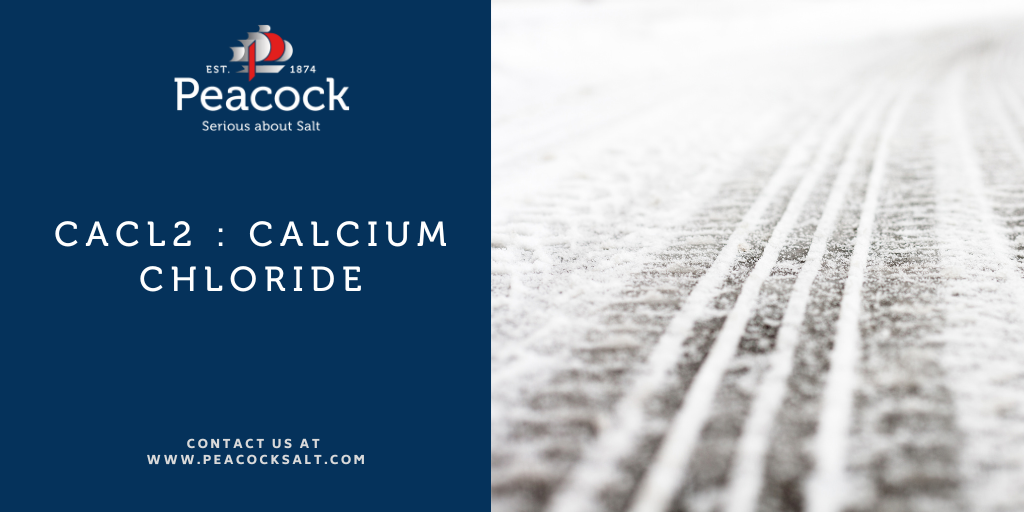
CaCl2 : Calcium Chloride
Ok, so we all know that salt is a great de-icer to about -7°C: it is relatively cheap (especially the brown stuff) spreadable or sprayable as brine and is used domestically, industrially and in local governments across the board in the UK. However, sometimes when the weather is extremely cold, it just isn’t good enough, or is, quite frankly redundant as a de-icer, so what do we do then?
In certain circumstances alternatives are required. This @Peacock_Salt blog will explore the properties and uses of CALCIUM CHLORIDE or CaCl2, the most widely used non-sodium de-icer. As you will see, Calcium chloride is multi-talented and has a range of other unexpected uses as well as for de-icing.
Firstly, a brief look at the chemistry… Calcium Chloride is an ionic compound of calcium and chlorine. It is commonly derived from limestone but is also produced as a by-product of the Solvay Process. This is the process used to create washing soda/soda ash or sodium carbonate which is a key ingredient for laundry soaps and a ton of other household products and, fundamentally, glass: in fact, the world demand for sodium carbonate stands at over 50 million tonnes per year! As for the by-product, Calcium Chloride, it has some pretty impressive properties which are really useful too.
CaCl2 is especially soluble in water and will deliquesce/ liquefy easily when it is in contact with water. This characteristic of readily absorbing water is known as to chemists as being ‘hygroscopic’. A wonderful example of hygroscopic effects in practice is the way that Australia’s Thorny Devils or Dragons keep themselves hydrated: they collect moisture in the dry desert by the condensation of dew on their bodies at night. This dew forms on its skin, and then it is channelled to its mouth in hygroscopic grooves between its spines – who knew?
Through common misspelling and confusion, hygroscopic is often morphed into ‘hydroscopic’ which is actually the word to use when describing an optical device used for viewing objects far below the surface of water, however, the apparent appeal of ‘hydroscopic’ has led to many of us lay folk describing Calcium Chloride as being such. Anyway, scientific quibbling over ancient Grecian descriptive words aside, practically speaking, this means, when in its solid form, Calcium Chloride needs to be stored in a tightly sealed container.
It can be found in pellet form, flakes, solutions or powders. Although it has low toxicity, and is relatively safe, if concentrated it can be harmful and so it is recommended that a mask /safety goggles/protective clothing/gloves etc are worn.
Secondly, how it is used… Its HYDROSCOPIC/HYGROSCOPIC nature is the main reason why Calcium Chloride is such an effective de-icer: when it is in contact with ice, it dissolves rapidly into brine, this creates heat which melts the ice as well as lowering the freezing point of the water held in the brine. Because it depresses the freezing point of water it is particularly effective as a pre-emptive prevention of ice formation as well as melting it. In a solid form, it can be used for temperatures to -32°C, and as a liquid, it can be effective to an impressive −52 °C. It can be sprayed or spread and, naturally, @Peacock_salt stock it in all of its forms, as well as the appropriate mechanisms for distributing it – please contact us for further details.
Its hydroscopic abilities also mean that CaCl2 is used in the US used to control dust on roads and tracks. It is helpful in the production of concrete as it accelerates the drying speed of poured concrete. Similarly, it is used in the laboratory and related processed for drying operations.
It is also used in the manufacture of plastics and production of calcium salt and in the drilling of oil and gas, whilst more everyday uses include the addition of Calcium Chloride to swimming pools, fabric softeners and fire extinguishers. Some farm equipment even has tyres filled with it to act as a no-freeze ballast for stability.
But it does not stop there: it is used it as a stabiliser/preservative/flavour enhancer in food - you might find it in your favourite jar of pickles. It is used as a source of calcium in cheese-making, beer brewing, sports drinks and is cleverly sprayed on apple trees to protect the fruit from cork-spot or bitter-pit.
Calcium Chloride, being a lover of long words and scientific processes, is a primary ingredient for spherification. Here, it is used with sodium alginate to shape liquid into squishy spheres – which look much like caviar. Various flavours of juice can be mixed with sodium alginate and dripped into a bowl of cold CaCl2. Each droplet forms a small ball with a soft, flexible skin which can then be in used in food or drinks.
It has a range of uses in the medical world including, unsurprisingly, to treat hypocalcaemia (lack of calcium), as an injection for certain heart complications, in the treatment of depression (from a magnesium sulphate overdose) or lead poisoning. It is even helpful in combating the symptoms of insect bites and stings for example that of the black widow spider.
And so it goes on…!
Here at Peacock Salt, we fully appreciate the advantages that Calcium Chloride brings to the de-icing world, especially when the weather gets more than just cold. We would be happy to advise on its use and suitability, so please do not hesitate to contact us should you have any queries or requirements with respect to the wonderful CaCl2.
